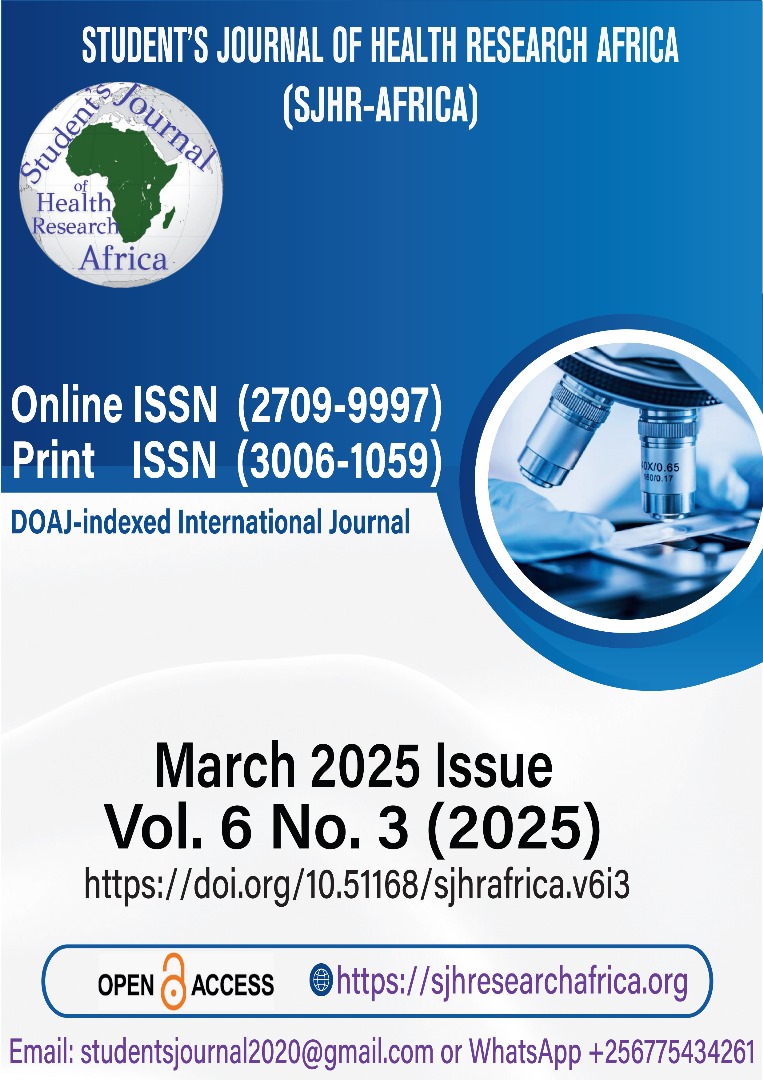EVALUATION OF CENTRAL AND PERIPHERAL ANALGESIC ACTIVITY OF CETRIZINE IN MICE: A RANDOMIZED CONTROL STUDY.
DOI:
https://doi.org/10.51168/sjhrafrica.v6i3.1644Keywords:
Analgesic activity, amitriptyline, cetirizine, diclofenac, tail flick test, tail clip test, writhing testAbstract
Background
Pain management is challenging due to the subjective nature of pain and the limitations of existing analgesics. Histamine and serotonin pathways play a role in pain modulation, suggesting potential analgesic effects of cetirizine and amitriptyline. While amitriptyline has shown some efficacy, cetirizine’s role in pain relief remains unclear. This study evaluates their analgesic potential of cetrizine individually and with diclofenac in mice.
Methods
Albino Swiss mice (n=24) were divided into four groups to evaluate the analgesic effects of amitriptyline and cetirizine, compared to diclofenac. Pain response was assessed using the tail flick (thermal), tail clip (physical), and writhing (chemical) tests at multiple time points. Drugs were administered orally, and the percentage inhibition of writhing was calculated.
Results
Amitriptyline exhibited the highest analgesic effect in the tail flick test (13.50±0.342 sec at 90 min), followed by diclofenac (11.00±0.365 sec) and cetirizine (8.00±0.365 sec). In the tail clip test, diclofenac and amitriptyline showed peak response times of 12.66±0.323 sec and 12.16±0.342 sec, respectively. Cetirizine was less effective in both tests. In the writhing test, diclofenac had the highest inhibition (65.85%), followed by cetirizine (41.46%), while amitriptyline showed the least effect (19.50%). These findings confirm significant analgesic properties of all tested drugs, with varying efficacy.
Conclusion
Amitriptyline showed the most prolonged analgesic effect in thermal and mechanical pain models, while diclofenac was most effective in visceral pain inhibition. Cetirizine demonstrated moderate analgesic activity.
Recommendation
Cetirizine may be considered as a supportive analgesic agent, especially when conventional NSAIDs pose risks, warranting further studies on its analgesic mechanisms and clinical applications.
References
Bennett PN, Brown MJ. Nervous System: Pain and analgesics. In: Clinical Pharmacology. 10th ed. Edinburgh, Scotland: Churchill Livingstone; 2008:293-6. https://doi.org/10.1016/B978-0-443-10244-8.10017-5
Guyton & Hell, textbook of medical physiology, A South Asian Edition; p 698-699
Sallmann, Alfred R. "The history of diclofenac." The American journal of medicine 80.4 (1986): 29-33.https://doi.org/10.1016/0002-9343(86)90076-8 PMid:3085489
Krupp, P., R. Menasse, and R. Ziel. "Chemistry and pharmacology of diclofenac in Voltaren." Proceedings of a Symposium held during the VIIIth European Rheumatology Congress. Hans Huber Publishers Bern, 1976.
Rang HP, Dale MM, Ritter JM, Flower RJ, Henderson G. Neural mechanism of pain. In: Rang and Dale's Pharmacology. 7th edn. Edinburgh: Elsevier; 2012:505-6. https://doi.org/10.1016/B978-0-7020-3471-8.00001-9
Babe KS, Serafin WE. Histamine, bradykinin, and their antagonists. In: Brunton LL, Chabner BA, Knollmann BC, editors. Goodman & Gilman's The Pharmacological Basis of Therapeutics. 12th ed. New York: McGraw-Hill; 2011:920-6.
Mobarakeh JI, Sakurada S, Katsuyama S, Kutsuwa M, Kuramasu A, Lin ZY, et al. Role of histamine H(1) receptor in pain perception: a study of the receptor gene knockout mice. Eur J Pharmacol 2000;391:81-9. https://doi.org/10.1016/S0014-2999(00)00060-1 PMid:10720638
Malmberg-Aiello P, Lamberti C, Ipponi A, Bartolini A, Schunack W. Evidence for hypernociception induction following histamine H1 receptor activation in rodents. Life Sci 1998;63:463-76. https://doi.org/10.1016/S0024-3205(98)00295-1 PMid:9718070
Bowsher D et al, Pain syndromes and their treatment, Curr. Opin. Neurol. Neurosurg, 1993 Apr., 6(2),257-63.
Sternbac A, Jenowsky DS et al, Effects of altering brain serotonin activity on human chronic pain, Advances in pain research & Therapy, vol .1 Ravens presses, New York, 1976, 601-606.
Pawar, Ganesh, Shrikant Dharmadhikari, and Jugalkishore Jaju. Comparison Of Analgesic Activity Of Tricyclic Antidepressants And Selective Serotonin Reuptake Inhibitors In Mice. Journal of Drug Delivery and Therapeutics 3.6 (2013): 70-75. https://doi.org/10.22270/jddt.v3i6.702
Tura B, Tura SM, The analgesic effect of tricyclic antidepressants, Brain Res.,1990 Jun,4,518(1-2),19-27.
https://doi.org/10.1016/0006-8993(90)90948-B PMid:2143961
Bourgoin, Oliveras JL et al, Electrical stimulation of the nucleus raphe magnus in the rat- Effects on 5HT metabolism in the spinal cord, Brain Res,1980 Aug.,4,194(2),577-89. https://doi.org/10.1016/0006-8993(80)91219-6 PMid:6155975
Oliver's JL, Sierralta F et al, Involvement of serotonergic system in analgesia induced by electrical stimulation of brain stem area, J. Physiol (Paris),1981,77(2-3),473-82.
Priya M, Sathya Narayanan V, Satyajit Mohapatra, Jamuna Rani R Int J Basic Clin Pharmacol. 2013 Apr;2(2):187-192 https://doi.org/10.5455/2319-2003.ijbcp20130313
Kanda N, Watanabe S. Histamine enhances the production of nerve growth factor in human keratinocytes. J Invest Dermatol 2003;121:570-7.https://doi.org/10.1046/j.1523-1747.2003.12428.x PMid:12925217
Lipnik-Stanglj M, Carman-Krzan M. The effects of histamine and interleukin-6 on NGF release from cortical astrocytes in primary culture. Pflugers Arch 2000;440(5 Suppl):R99-100. https://doi.org/10.1007/s004240000021 PMid:28008497
Watson JJ, Allen SJ, Dawbarn D. Targeting nerve growth factor in pain: what is the therapeutic potential? BioDrugs 2008;22:349-59.https://doi.org/10.2165/0063030-200822060-00002 PMid:18998753
Lewin GR, Mendell LM. Nerve growth factor and nociception. Trends Neurosci 1993;16:353-9. https://doi.org/10.1016/0166-2236(93)90092-Z PMid:7694405
Thurmon JC, Tranquilli WJ, Benson GJ: Perioperative pain and distress. In Lumb and Jones Veterinary Anesthesia, ed 3. Baltimore, Lea & Febiger, 1996, pp 40-60.
Downloads
Published
How to Cite
Issue
Section
License
Copyright (c) 2025 Ishteyaque Ahmad, Amritanshu Shekhar, Shantanu Vats, Gandham Ravi, Shilpi Mishra

This work is licensed under a Creative Commons Attribution-NonCommercial-NoDerivatives 4.0 International License.






















